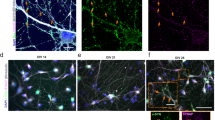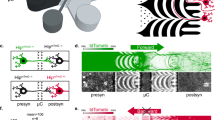Abstract
Aggregated alpha-synuclein (α-Syn) in neurons is a hallmark of Parkinson’s disease (PD) and other synucleinopathies. Recent advances (1) in the production and purification of synthetic assemblies of α-Syn, (2) in the design and production of microfluidic devices allowing the construction of oriented and compartmentalized neuronal network on a chip, and (3) in the differentiation of human pluripotent stem cells (hPSCs) into specific neuronal subtypes now allow the study of cellular and molecular determinants of the prion-like properties of α-Syn in vitro. Here, we described the methods we used to reconstruct a cortico-cortical human neuronal network in microfluidic devices and how to take advantage of this cellular model to characterize (1) the prion-like properties of different α-Syn strains and (2) the neuronal dysfunctions and the alterations associated with the exposure to α-Syn strains or the nucleation of endogenous α-Syn protein in vitro.
Access this chapter
Tax calculation will be finalised at checkout
Purchases are for personal use only
Similar content being viewed by others
References
Goedert M, Spillantini MG, Del Tredici K et al (2013) 100 years of Lewy pathology. Nat Rev 9(1):13–24
Spillantini MG, Schmidt ML, Lee VM et al (1997) Alpha-synuclein in Lewy bodies. Nature 388(6645):839–840
Desplats P, Lee HJ, Bae EJ et al (2009) Inclusion formation and neuronal cell death through neuron-to-neuron transmission of alpha-synuclein. Proc Natl Acad Sci U S A 106(31):13010–13015
George S, Rey NL, Reichenbach N et al (2013) Alpha-Synuclein: the long distance runner. Brain Pathol 23(3):350–357
Guo JL, Covell DJ, Daniels JP et al (2013) Distinct alpha-synuclein strains differentially promote tau inclusions in neurons. Cell 154(1):103–117
Hansen C, Angot E, Bergström A-L et al (2011) α-Synuclein propagates from mouse brain to grafted dopaminergic neurons and seeds aggregation in cultured human cells. J Clin Invest 121(2):715–725
Luk KC, Kehm V, Carroll J et al (2012) Pathological alpha-synuclein transmission initiates Parkinson-like neurodegeneration in nontransgenic mice. Science 338(6109):949–953
Peelaerts W, Bousset L, Van der Perren A et al (2015) Alpha-Synuclein strains cause distinct synucleinopathies after local and systemic administration. Nature 522(7556):340–344
Sacino AN, Brooks M, Thomas MA et al (2014) Intramuscular injection of α-synuclein induces CNS α-synuclein pathology and a rapid-onset motor phenotype in transgenic mice. Proc Natl Acad Sci U S A 111(29):10732–10737
Volpicelli-Daley LA, Luk KC, Patel TP et al (2011) Exogenous α-synuclein fibrils induce Lewy body pathology leading to synaptic dysfunction and neuron death. Neuron 72(1):57–71
Courte J, Bousset L, Boxberg YV et al (2020) The expression level of alpha-synuclein in different neuronal populations is the primary determinant of its prion-like seeding. Sci Rep 10(1):4895
Hafezparast M, Klocke R, Ruhrberg C et al (2003) Mutations in dynein link motor neuron degeneration to defects in retrograde transport. Science 300(5620):808–812
Macia E, Ehrlich M, Massol R et al (2006) Dynasore, a cell-permeable inhibitor of dynamin. Dev Cell 10(6):839–850
Volpicelli-Daley LA, Luk KC, Lee VM-Y (2014) Addition of exogenous α-synuclein preformed fibrils to primary neuronal cultures to seed recruitment of endogenous α-synuclein to Lewy body and Lewy neurite-like aggregates. Nat Protoc 9(9):2135–2146
Fenyi A, Coens A, Bellande T et al (2018) Assessment of the efficacy of different procedures that remove and disassemble alpha-synuclein, tau and A-beta fibrils from laboratory material and surfaces. Sci Rep 8:10788
Acknowledgments
This project has received funding from the Innovative Medicines Initiative 2 Joint Undertaking, under grant agreements No. 116060 (IMPRiND) and No. 821522 (PD-MitoQUANT); the European Union’s Horizon 2020 research and innovation program and EFPIA; the Swiss State Secretariat for Education‚ Research and Innovation (SERI) under contract number 17.00038; the Parkinson UK; the European Commission: MicroDEG, ERA-NET Neuron JTC2012 “Novel Methods” (J-M.P. and A.L.P.); the CNRS (L.B, RM, J-M.P.); the Inserm (A.L.P.); the Laboratoire d’Excellence Revive (ANR-10-LABX-73, A.L.P.); the NeurATRIS (ANR-11-INBS-0011, A.L.P.); and the H2020 Project Joint Programme – Neurodegenerative Disease Research (JPND) ModelPolyQ grant 643417, A.L.P.). I-Stem is supported by the Association Française contre les Myopathies (AFMTelethon). The opinions expressed and arguments employed herein do not necessarily reflect the official views of these funding bodies.
Author information
Authors and Affiliations
Corresponding authors
Editor information
Editors and Affiliations
Rights and permissions
Copyright information
© 2023 Springer Science+Business Media, LLC, part of Springer Nature
About this protocol
Cite this protocol
Gribaudo, S., Bousset, L., Courte, J., Melki, R., Peyrin, JM., Perrier, A.L. (2023). Propagation of Distinct α-Synuclein Strains Within Human Reconstructed Neuronal Network and Associated Neuronal Dysfunctions. In: Cieplak, A.S. (eds) Protein Aggregation. Methods in Molecular Biology, vol 2551. Humana, New York, NY. https://doi.org/10.1007/978-1-0716-2597-2_24
Download citation
DOI: https://doi.org/10.1007/978-1-0716-2597-2_24
Published:
Publisher Name: Humana, New York, NY
Print ISBN: 978-1-0716-2596-5
Online ISBN: 978-1-0716-2597-2
eBook Packages: Springer Protocols




